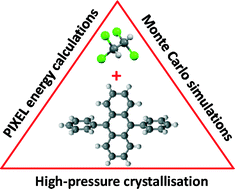X-ray diffraction and computational studies of the pressure-dependent tetrachloroethane solvation of diphenylanthracene†
Abstract
The crystal structure of the organic semiconductor 9,10-diphenylanthracene (DPA) has been studied by single-crystal X-ray diffraction at variable pressure up to 3 GPa. Under ambient conditions and in the presence of 1,1,2,2-tetrachloroethane, the material invariably crystallises in an unsolvated form, in the space group C2/c, with Z′ = 1/2, as reported in the literature. As pressure is increased to a modest 0.5 GPa, crystallisation occurs in the form of a newly discovered solvate with a 1 : 2 DPA–tetrachloroethane stoichiometry, with the space group P21/c. A theoretical analysis by the PIXEL method with energy partitioning into Coulombic polarisation and dispersion terms reveals that the solvated and unsolvated structures have in common two basic packing motifs for the DPA molecule, one with linear interlocking and one with a T-shaped arrangement in a quincunx fashion. The solvent is enclosed in a cage and interacts with the DPA molecule by a very strong dispersive component of 44 kJ mol−1. Monte Carlo simulations show that the mobility of the solvent in its cage would be extremely reduced even under ambient conditions, ruling out a mechanism of solvate formation and subsequent release. According to a structure-oriented perspective, the kinetics of the process could then be such that the nucleating system at ambient pressure separates out the solvent, while a 0.5 GPa pressure provides a solute–solvent grip that forces cocrystallisation, in agreement with both experiments and simulations. Even in the absence of experimental or computational proof of the thermodynamic stability of the solvate at high pressure, this appears to be a plausible and sensible case scenario in its own right.


 Please wait while we load your content...
Please wait while we load your content...